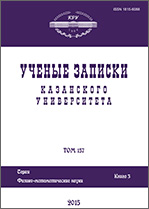|
|
Uchenye Zapiski Kazanskogo Universiteta. Seriya Fiziko-Matematicheskie Nauki, 2011, Volume 153, Book 3, Pages 215–227
(Mi uzku1069)
|
 |
|
 |
This article is cited in 3 scientific papers (total in 3 papers)
Black holes and quasiblack holes: some history and remarks
J. P. S. Lemos
Physics Department, Instituto Superior Técnico, Technical University of Lisbon, Lisbon, Portugal
Abstract:
We give a short reference to the two Schwarzschild solutions and to what Petrov had to say about them. We comment on how the Schwarzschild vacuum solution describes a black hole. Then we compare the properties, differences and similarities between black holes and quasiblack holes. Black holes are well known. Quasiblack hole is a new concept. A quasiblack hole, either nonextremal or extremal, can be broadly defined as the limiting configuration of a body when its boundary approaches the body's own gravitational radius (the quasihorizon). Quasiblack holes are objects that are on the verge of being black holes but actually are distinct from them in many ways. We display some of their properties: there are infinite redshift whole regions; the curvature invariants remain perfectly regular everywhere, in the quasiblack hole limit; a free-falling observer finds in his own frame infinitely large tidal forces in the whole inner region, showing some form of degeneracy; outer and inner regions become mutually impenetrable and disjoint, although, in contrast to the usual black holes, this separation is of a dynamical nature, rather than purely causal; for external far away observers the spacetime is virtually indistinguishable from that of extremal black holes. We also discuss other important properties, such as the mass formula and the entropy, as compared to the corresponding properties of black holes.
Keywords:
Schwarzschild solution, Petrov, black holes, quasiblack holes.
Received: 10.12.2010
Citation:
J. P. S. Lemos, “Black holes and quasiblack holes: some history and remarks”, Uchenye Zapiski Kazanskogo Universiteta. Seriya Fiziko-Matematicheskie Nauki, 153, no. 3, Kazan University, Kazan, 2011, 215–227
Linking options:
https://www.mathnet.ru/eng/uzku1069 https://www.mathnet.ru/eng/uzku/v153/i3/p215
|

| Statistics & downloads: |
| Abstract page: | 298 | | Full-text PDF : | 140 | | References: | 64 |
|




 Contact us:
Contact us: Terms of Use
Terms of Use
 Registration to the website
Registration to the website Logotypes
Logotypes









 Citation in format
Citation in format 